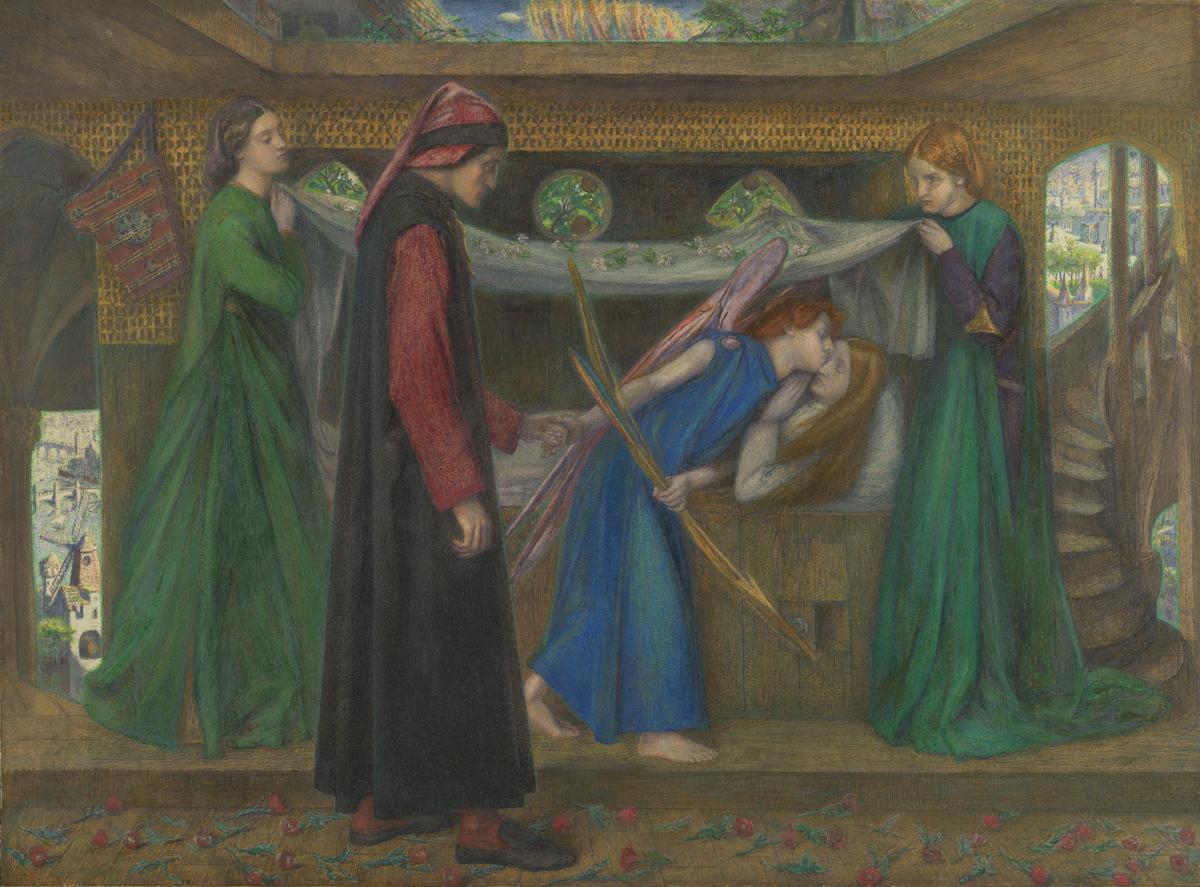The Pre Raphaelites, Rossetti in particular, produced marmite art, and for me it's best spread thinly. But Tate Britain's The Rossettis show promised something more - a pluralised approach and a emphasis on radicalism, so I went with an open mind. It started positively. The sound showers of Christina Rossetti's poetry were novel, but for an exhibition which purported to place such an emphasis on combining words and pictures and describes itself as 'immersive', that first room was oddly sparse. There was a sense of 'lets get the poetry out of the way' - the showers pretty much dried up and the poetry was largely left to Gabriel from then on.
This is the main problem with a show which claims to be about the Rossetti family by birth and marriage, but ends by giving two members - Maria and William - very short shrift, and by the last two rooms is all about one man. I'm not blaming the curators: they were set an impossible task. Poetry is never going to hold its own with paintings in an art gallery - although they could have made a better job of combining the two. Equally, whatever your views on Elizabeth Siddal's art, the reality is that she died young, and produced a relatively small body of small scale work. In gallery terms she simply can't compete with the prolific large scale production of her husband. The curators attempt to circumvent this imbalance by a tightly choreographed like for like approach with both artists presented as working off each other. This works well on the gallery walls: the juxtaposition of Siddal's Lady Fixing a Pennant to a Knight's Spear and Rossetti's The Tune of the Seven Towers, for instance, neatly illustrates compositional and subject similarities whilst highlighting Rossetti's greater interest in surface pattern and complexity.
Unfortunately, the approach creates a very insular view, at odds with the current narrative that Siddal deliberately approached the PRB with the aim of becoming an artist, and that she moved away to study at Sheffield School of Art and was financially supported by John Ruskin. The exhibition is also oddly coy about their personal relationship, indeed Gabriel's relationships with women generally. A particularly extreme example is the caption which suggests they delayed marriage to avoid children, implying a platonic courtship which seems hard to believe. Whilst the show is clearly going out of its way to avoid both a biographical Desperate Romantics narrative and one in which Siddal is reduced to mere muse (hence no Ophelia), the lack of context is disengaging and does her no favours.
The second thrust of the exhibition is radicalism, and this too the curators struggle to sustain. On a political level, and despite his Italian revolutionary family background, Gabriel is never more than a youthful dabbler. Found is a failed attempted to jump on the 'fallen woman' bandwagon - you can go upstairs to see Holman Hunt and Spencer Stanhope make a better fist of it. If you have to stretch to drawing out contemporary parallels from a drawing of feudalism - as the curators attempt with Millais' A Baron Numbering his Vassals - then you are surely losing the argument. The case for artistic radicalism is just as shaky. The Pre-Raphaelite Brotherhood were controversial, but because they were going backwards not forwards. And Rossetti was by no means the most controversial of the bunch: just compare his Girlhood of the Virgin with Millais' supposedly blasphemous Christ in the House of his Parents (another work you need to go upstairs to see).
Equally, Rossetti's contribution to aestheticism, which dominates the second half of the exhibition, may be significant, but is conservative compared with that of, say, Whistler. His idea of art for art's sake is essentially to paint the same ideal of feminine beauty over and over again, as the last two rooms of the show demonstrate. Even the exhibition's attempt at illustrating aesthetic design falls flat: a couple of pieces of furniture and some, admittedly very lovely, reconstructed wallpaper. You get more appreciation of contemporary taste from a small photograph of Frederick Leyland's drawing room displayed later in the exhibition.
If you strip it back, this is really a retrospective of one Rossetti: all Gabriel's main works are there and the last two rooms are a beautiful triumph, worth the admission price in their own right. The reuniting of the Leyland triptych of Mnemosyne, The Blessed Damozel and Proserpine is like three movements of a symphony, lush and absorbing, and the perfect - missed - moment for a sound shower. For me his best works are his small, intense watercolours where constricted space is further reduced by rich surface pattern. Here, surely, Rossetti is at his most radical: for all their narrative drive and Medievalism, there is an abstraction and an exploration of the medium which is utterly lacking in his largescale oils. The show also takes the trouble to show his process through the various attempts to resolve Found, and through the use of models in The Beloved.
Perhaps The Rossettis (plural) was never going to work: the Tate's own website only bothers to include Gabriel's paintings on their promotion page. Even if you take away the plural, it's very difficult to read highly finished, dreamy sensuality as a radical statement. Ultimately, however, this is an exhibition which fails to grasp the nettle. Rossetti's art cannot be understood without referencing his attitude to, and his relationships with, women, including Siddal. By the end of the show, I realised that the unhealthiness of his abusive dependency on a succession of models is what I find so unpalatable in his art. There's nothing beautiful about it.




No comments:
Post a Comment